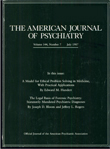Gene-environment interaction in vulnerability to schizophrenia: findings from the Finnish Adoptive Family Study of Schizophrenia
Abstract
OBJECTIVE: This study assessed the interaction of genetic risk and rearing-family risk as a subsyndromal test measure of schizophrenic thought disorder in adoptees. METHOD: A group of 58 adoptees with schizophrenic biological mothers was compared with 96 comparison adoptees at ordinary genetic risk; putative adoptee vulnerability was assessed blindly and reliably by using the Rorschach Index of Primitive Thought. Environmental risk was measured by using frequency of communication deviance as a continuous variable, scored independently from Rorschach assessments of the adoptive parents. RESULTS: High genetic risk in itself was not associated with greater vulnerability to schizophrenic thought disorder in the adoptees, as indicated by the Index of Primitive Thought. Also, greater communication deviance in the adoptive parents was not associated with greater thought disorder in the comparison adoptees. However, there was a highly significant gene- environment interaction. Among the offspring of the adoptive parents with high levels of communication deviance, a higher proportion of high- risk than comparison adoptees showed evidence of thought disorder. In contrast, among the offspring of adoptive parents with low communication deviance, a lower proportion of high-risk than comparison adoptees showed evidence of thought disorder. The distribution of communication deviance scores did not differ significantly between the adoptive parents of high-risk offspring and the adoptive parents of comparison offspring. CONCLUSIONS: The findings are consistent with genetic control of sensitivity to the environment. There is no evidence that high genetic risk of schizophrenia among offspring is associated with high levels of communication problems in rearing parents.



